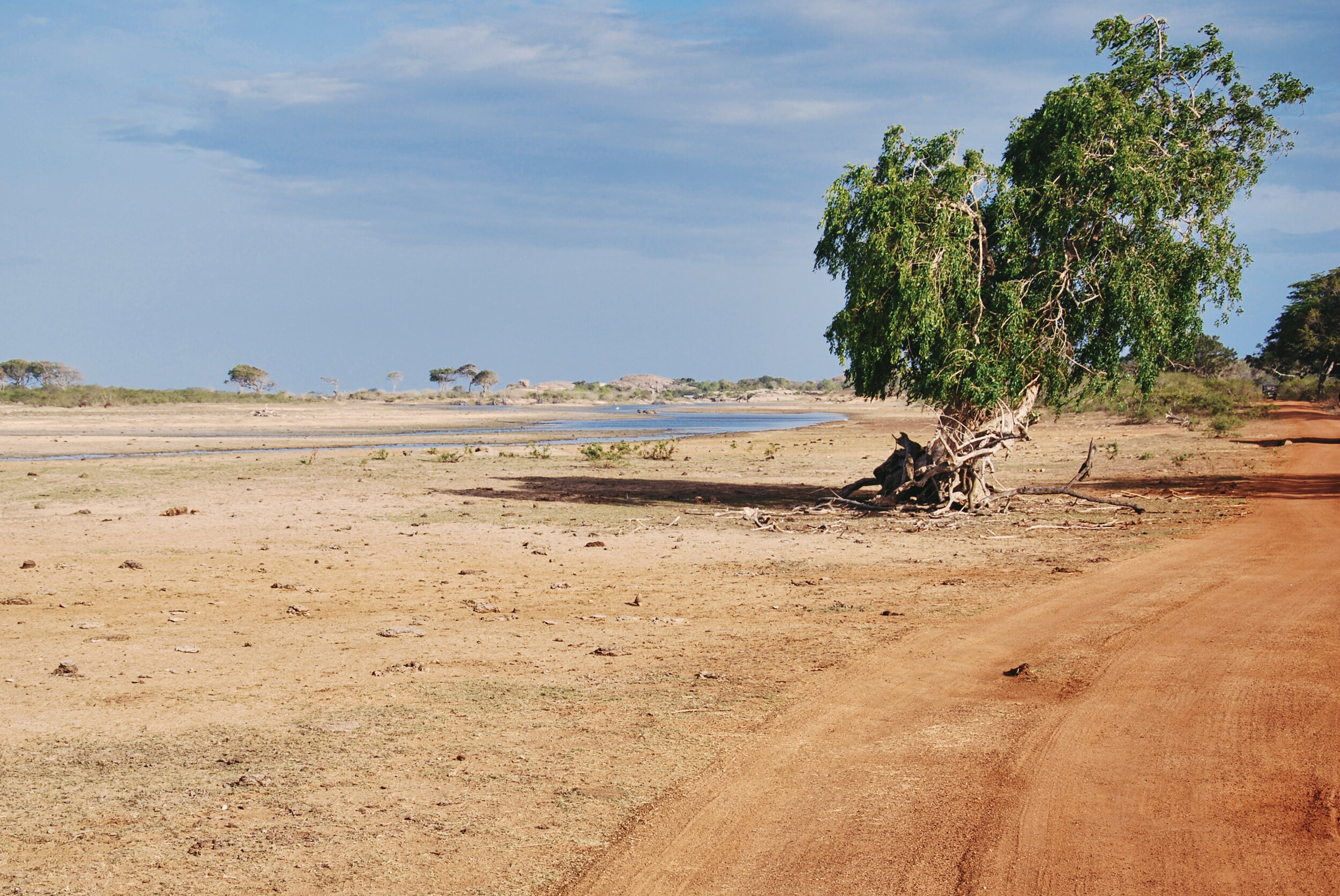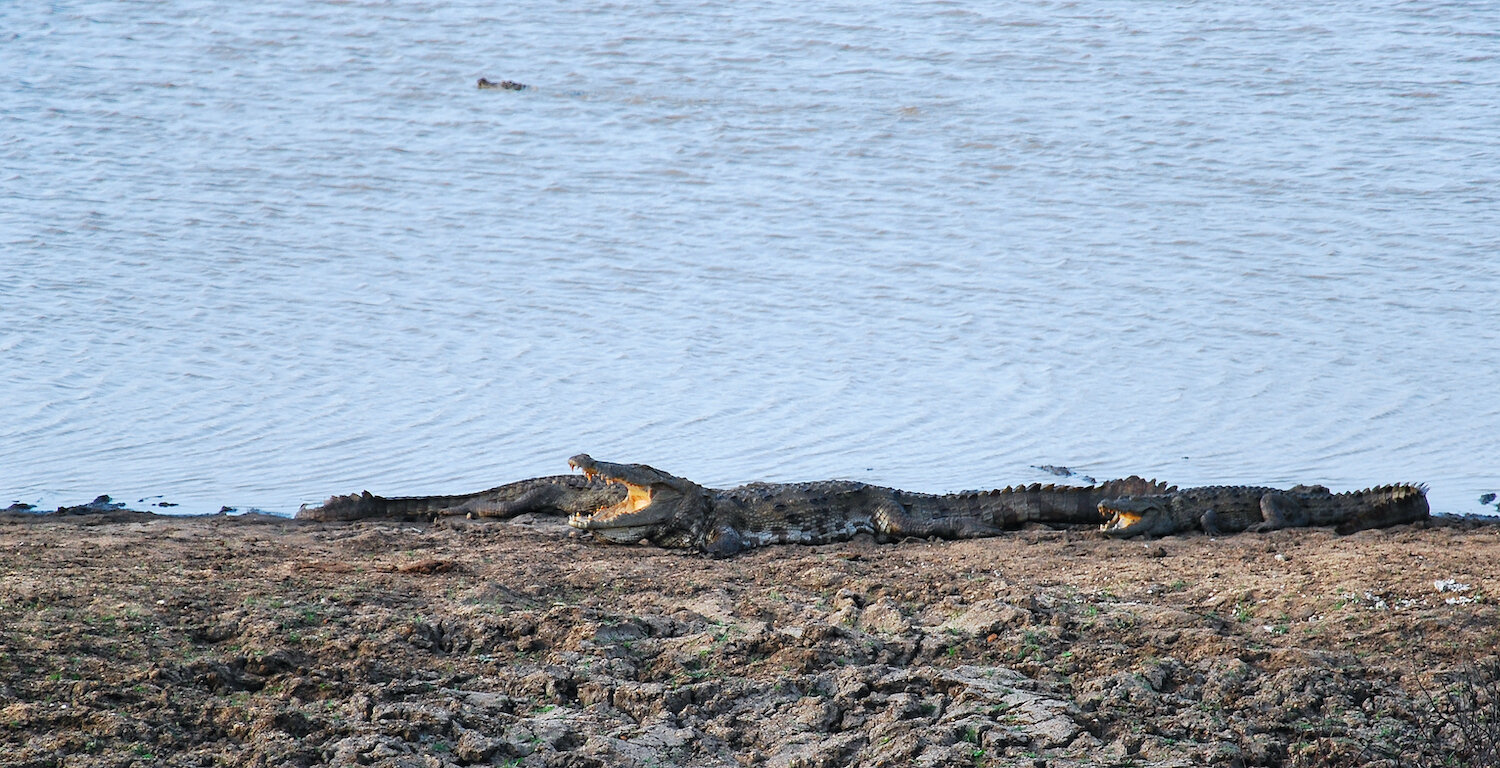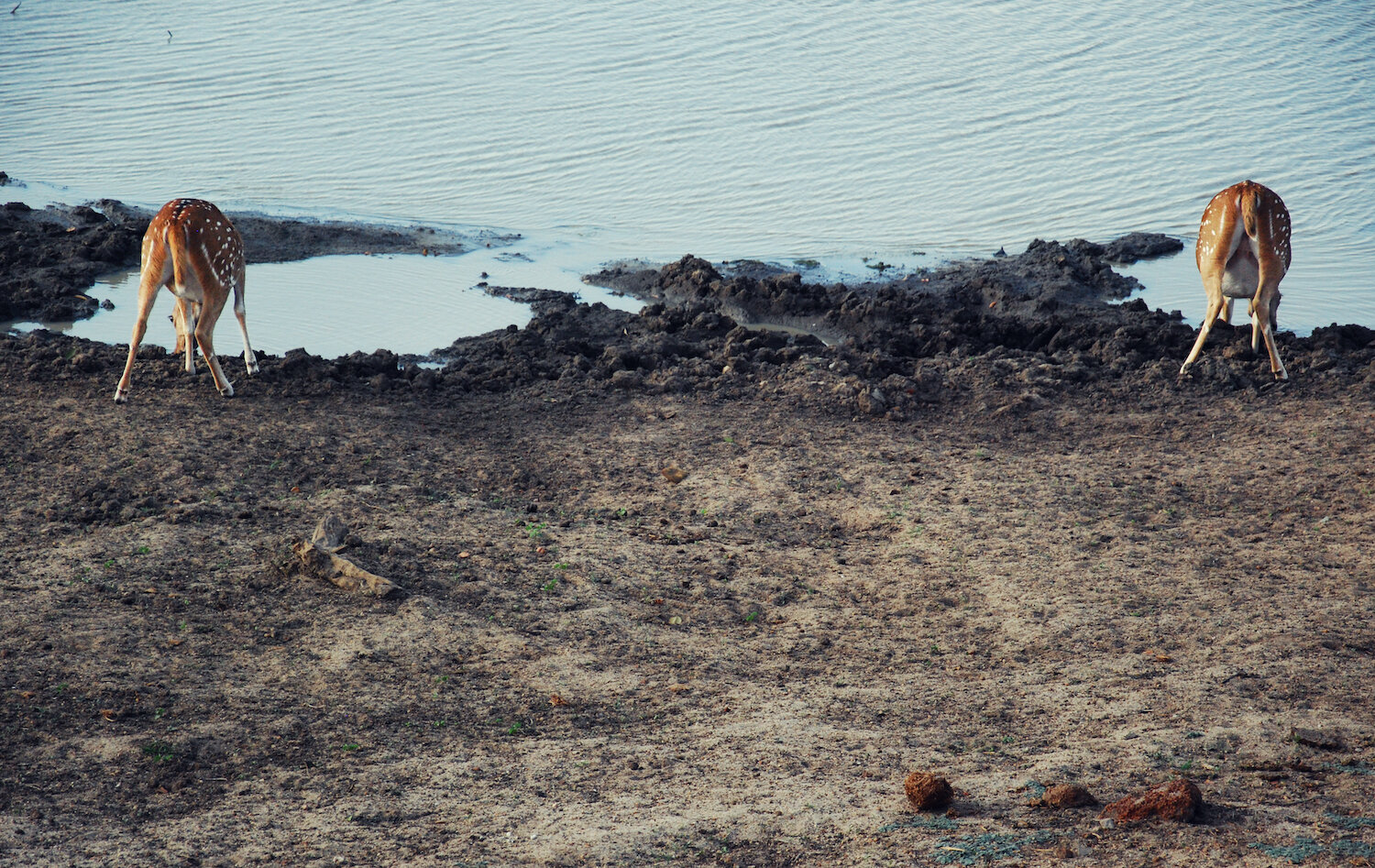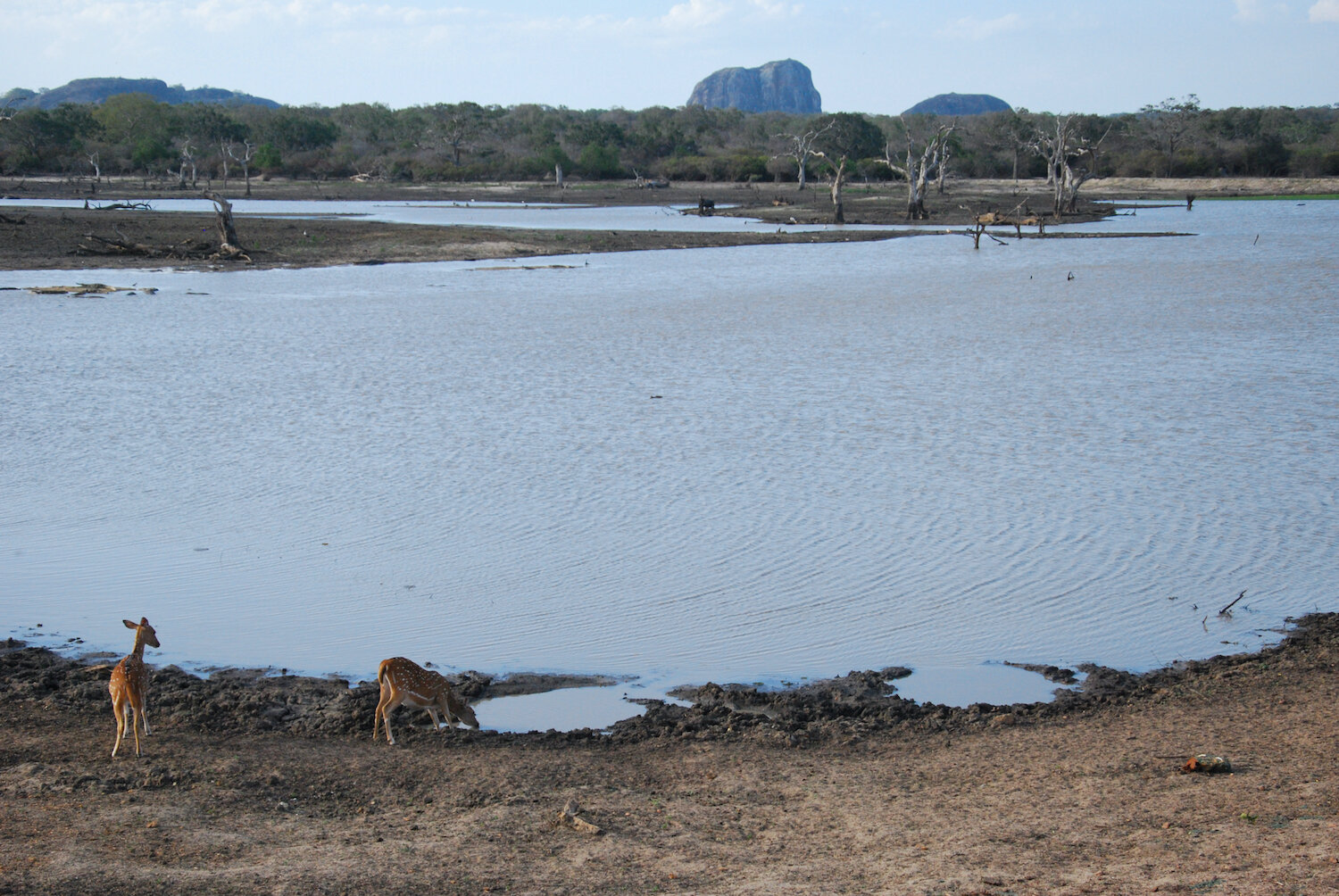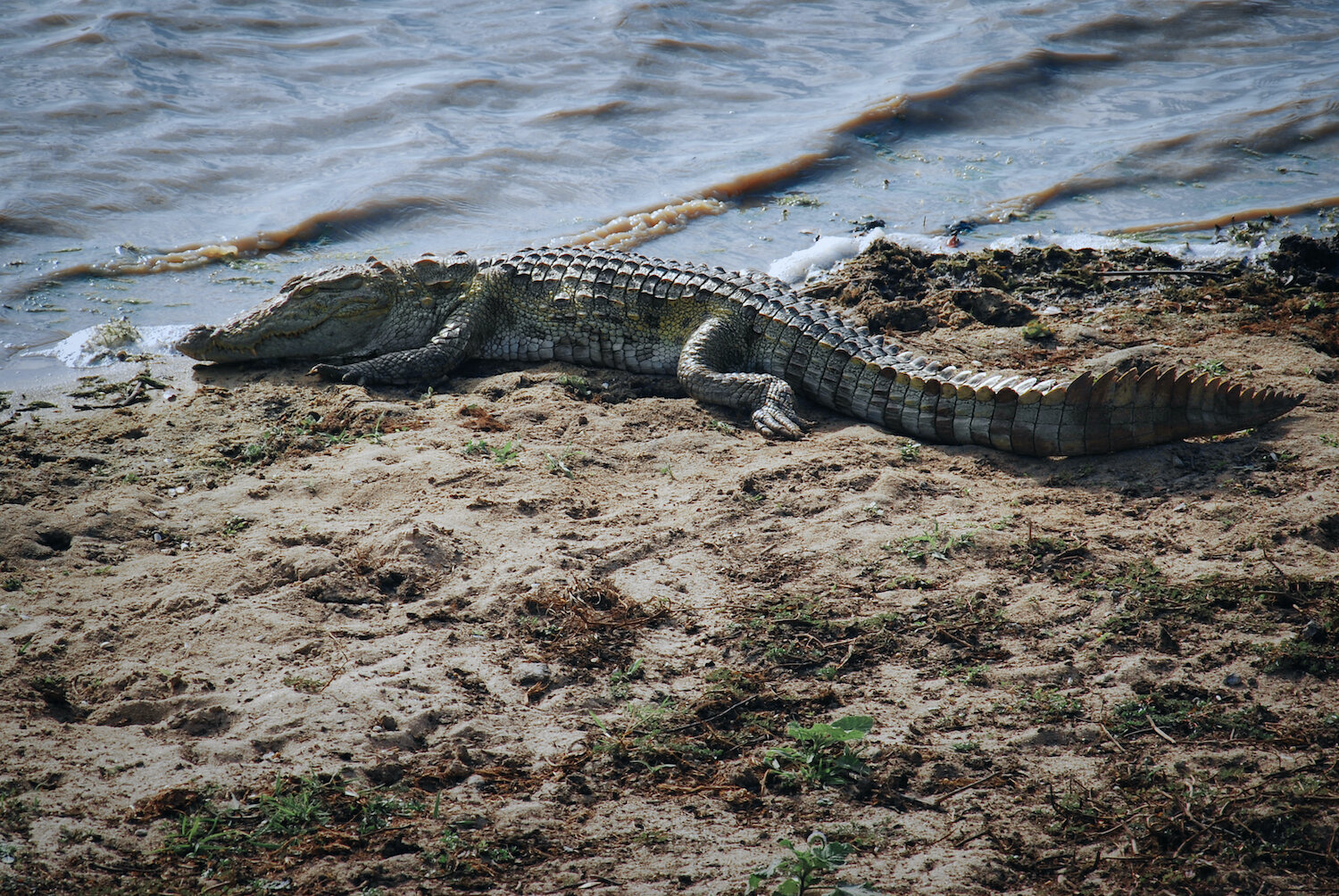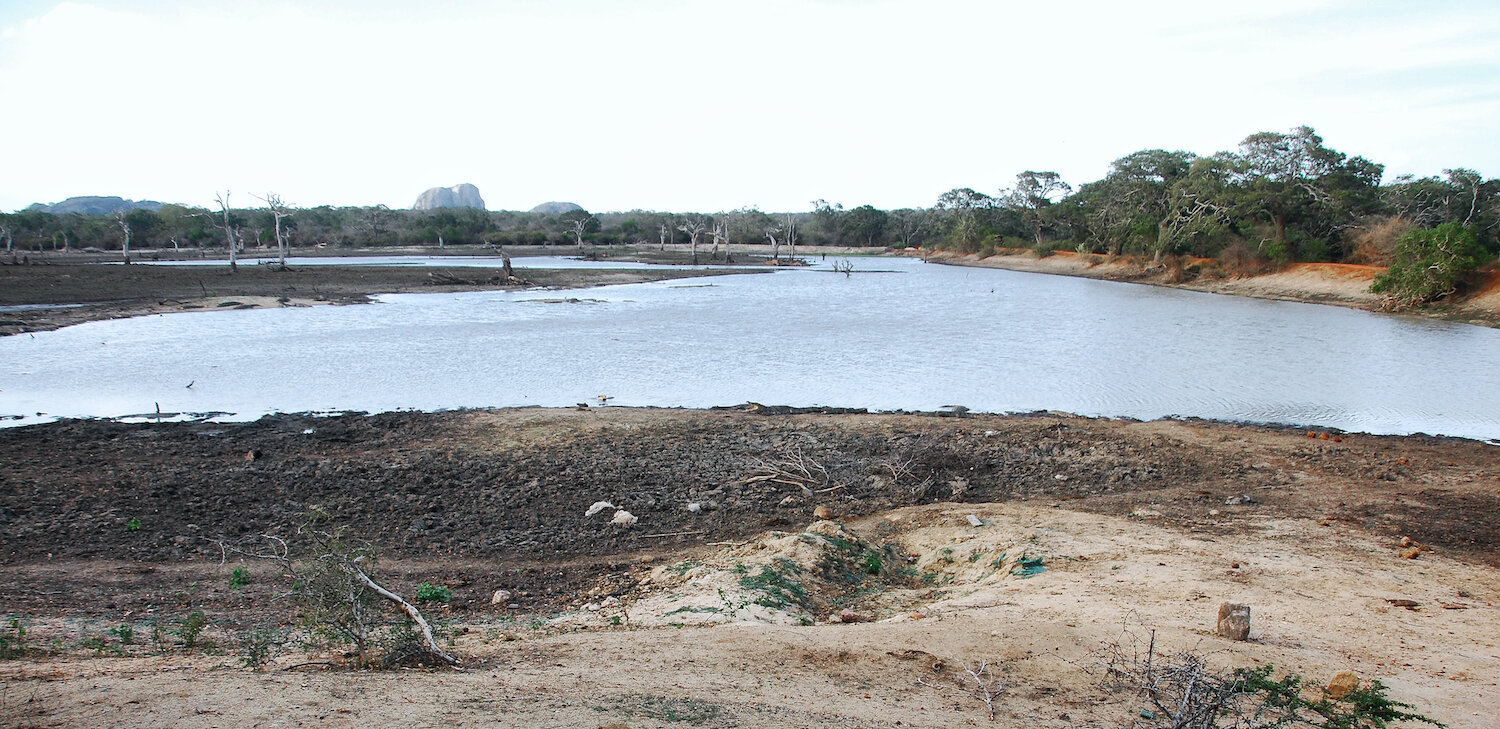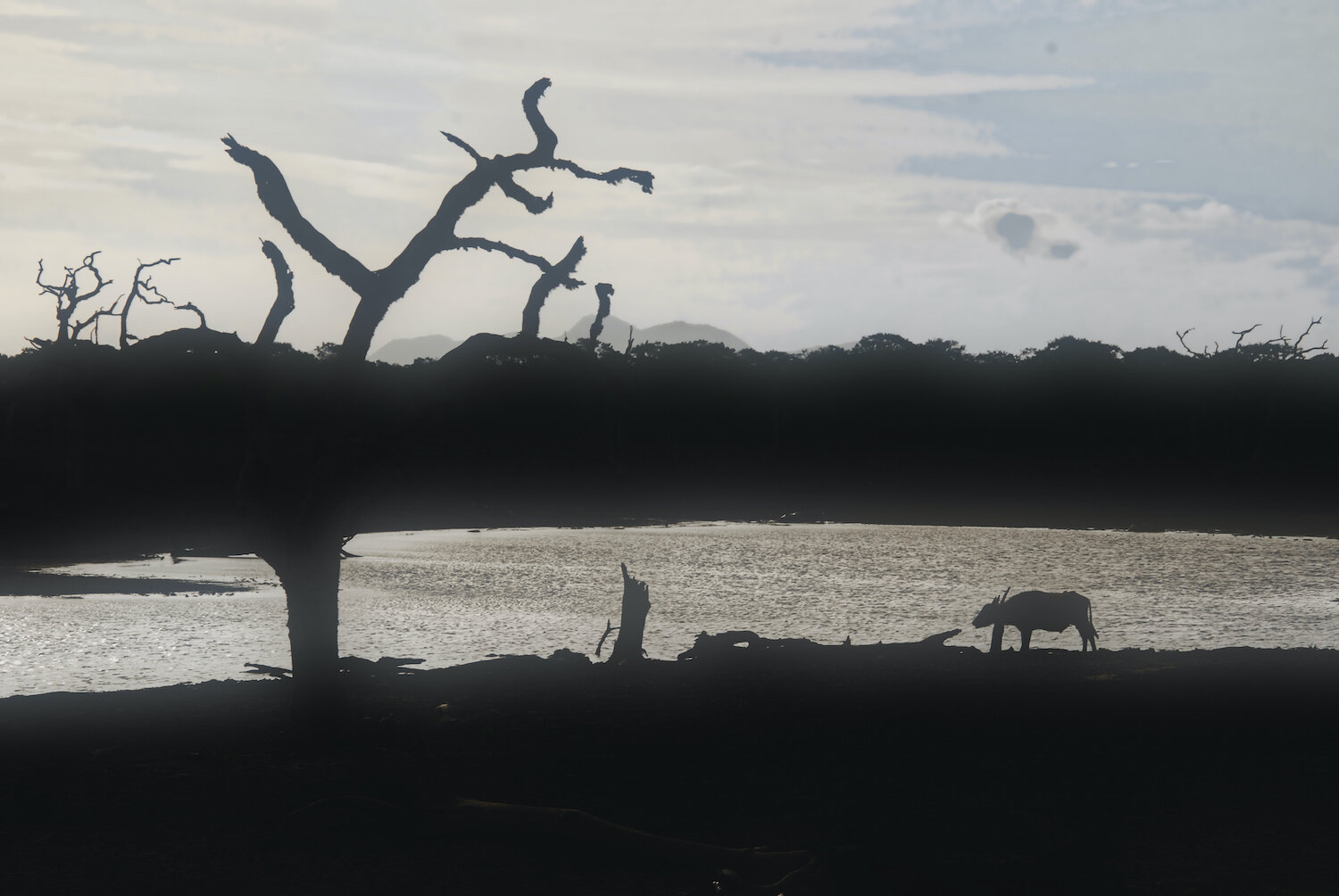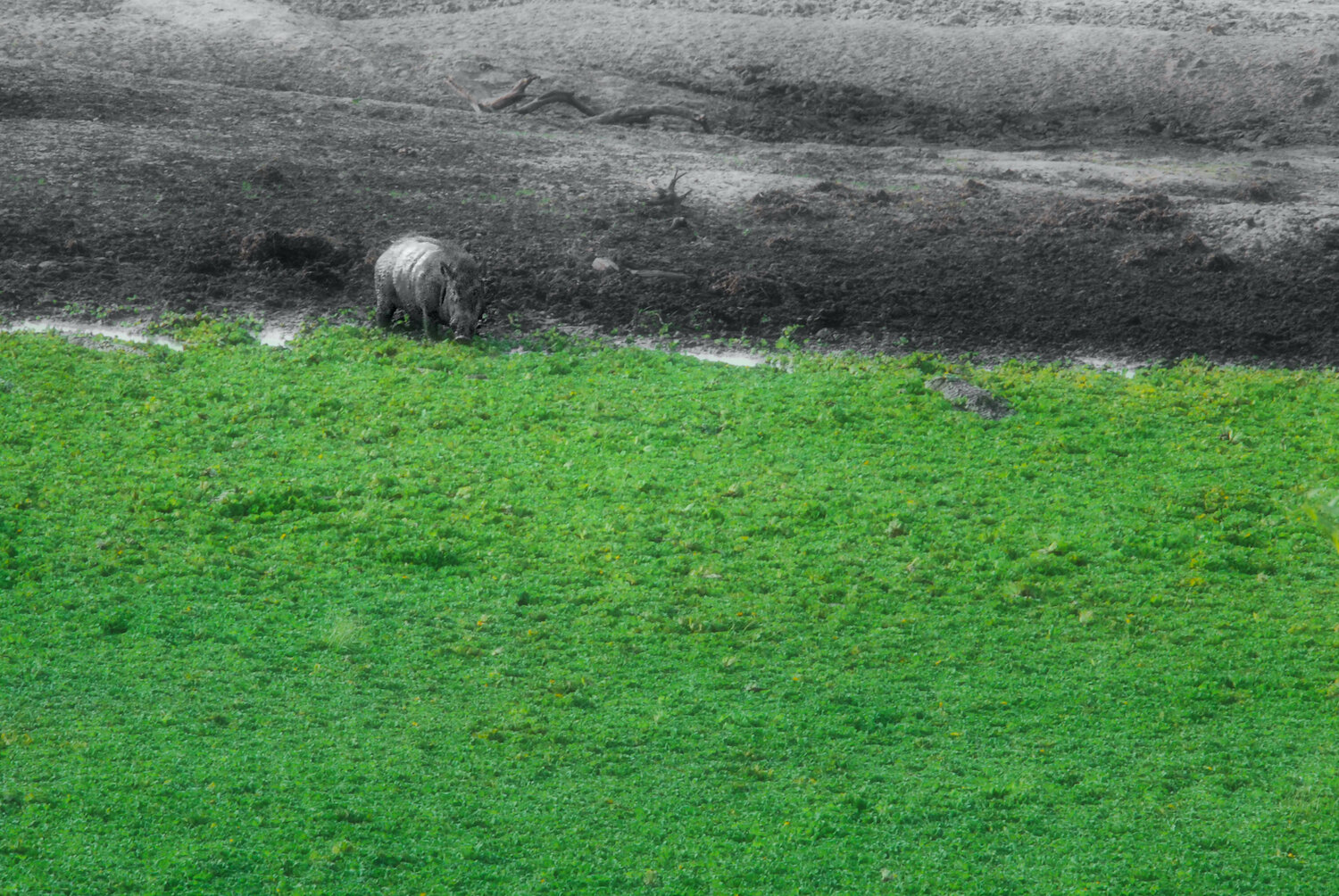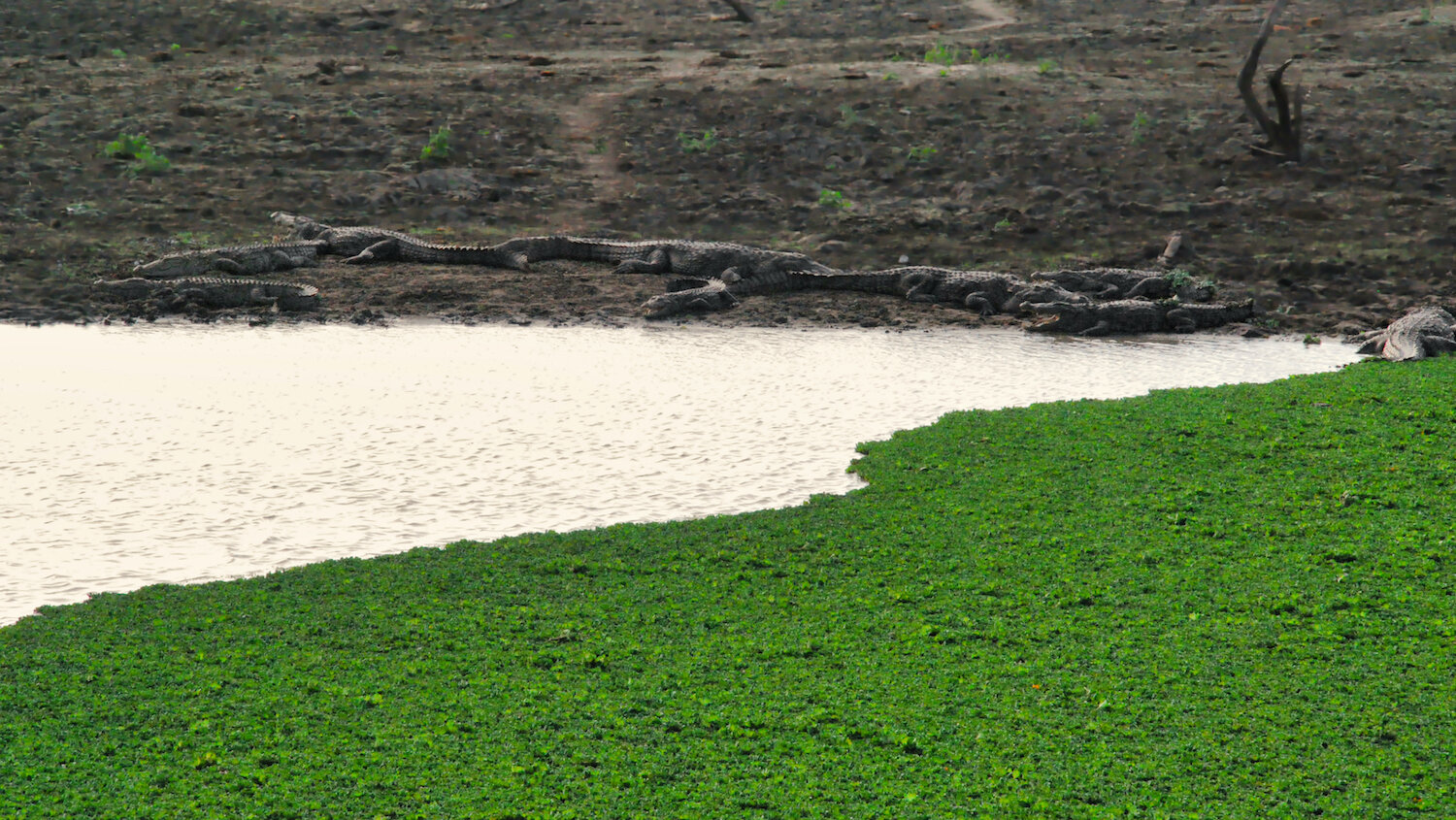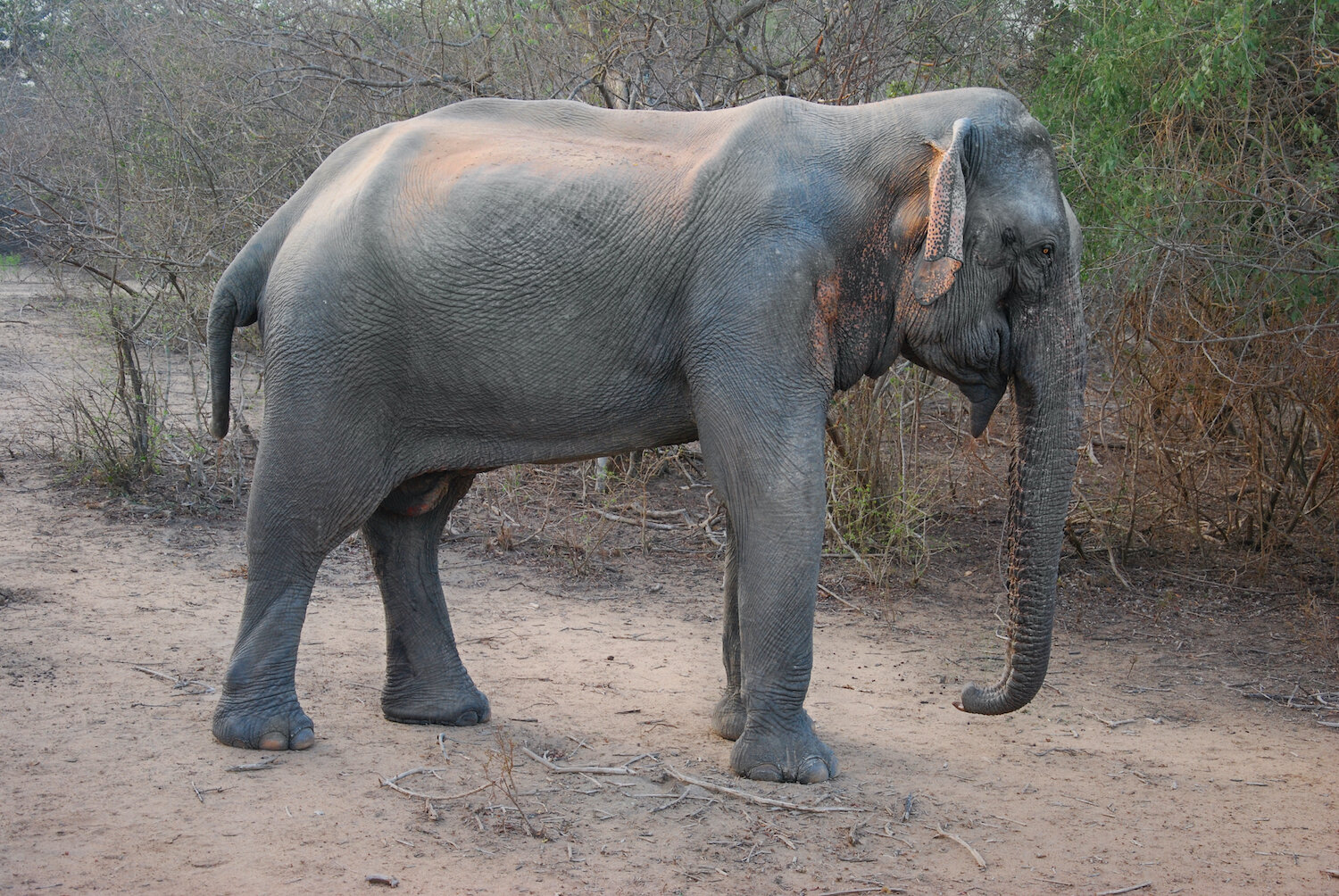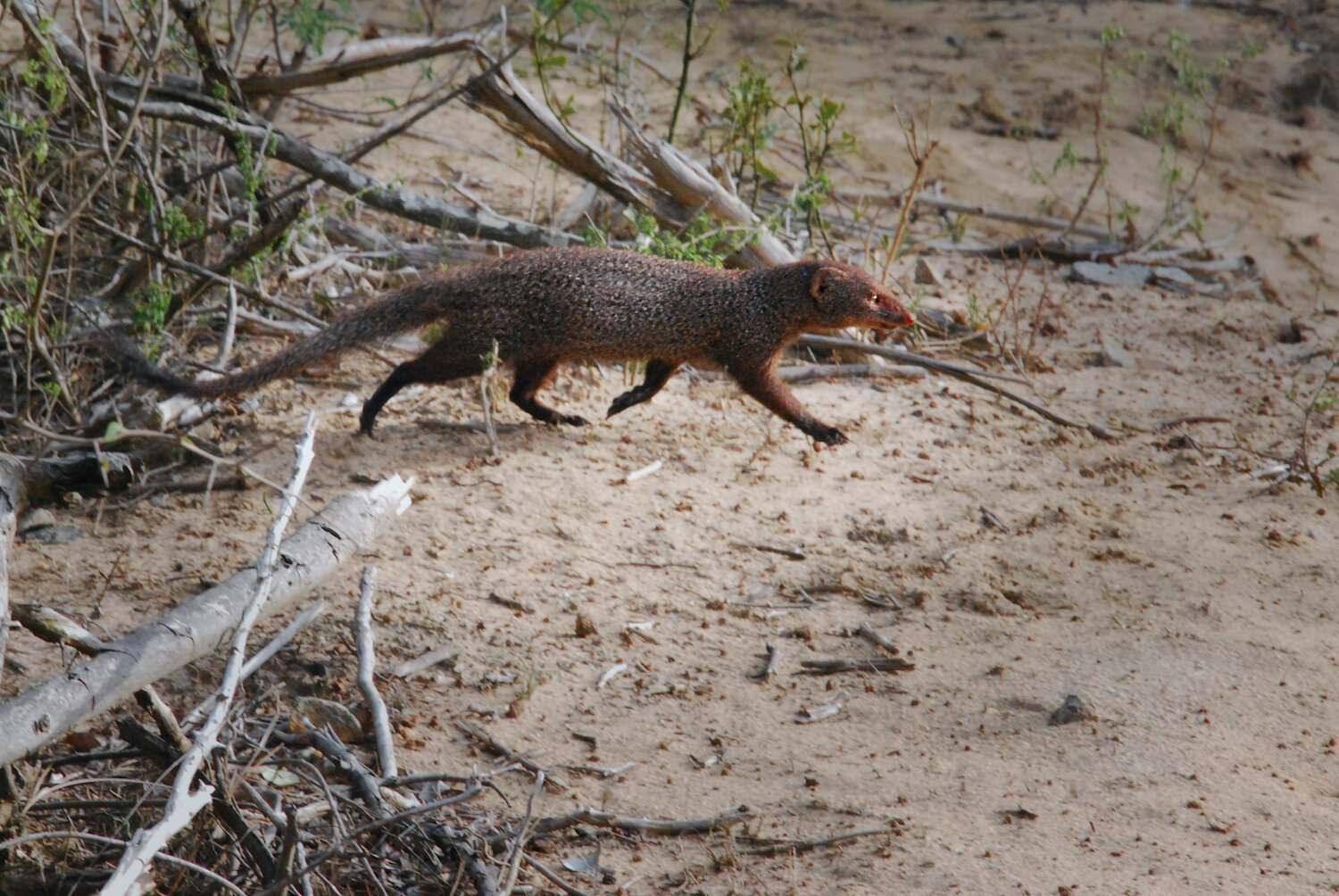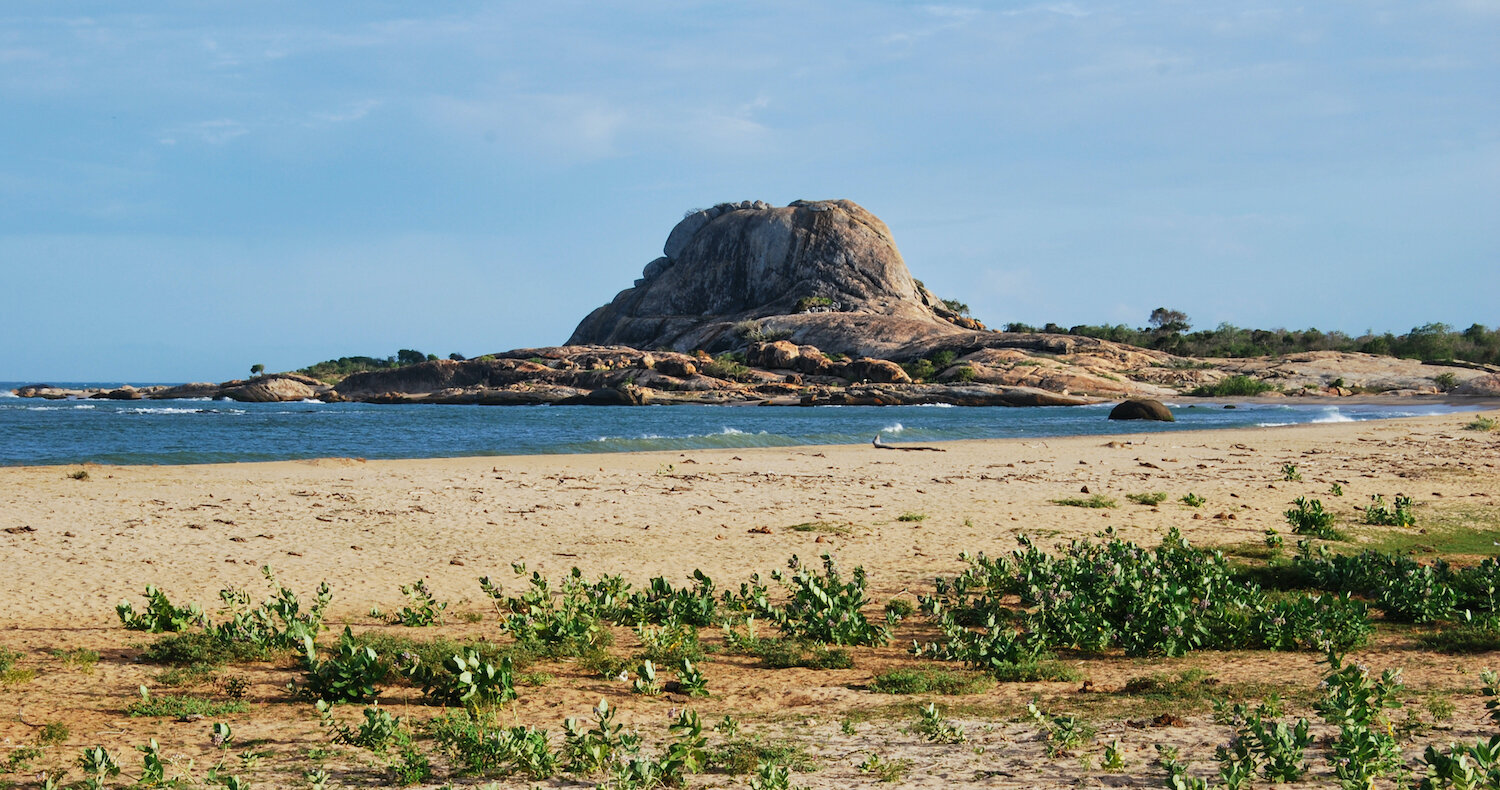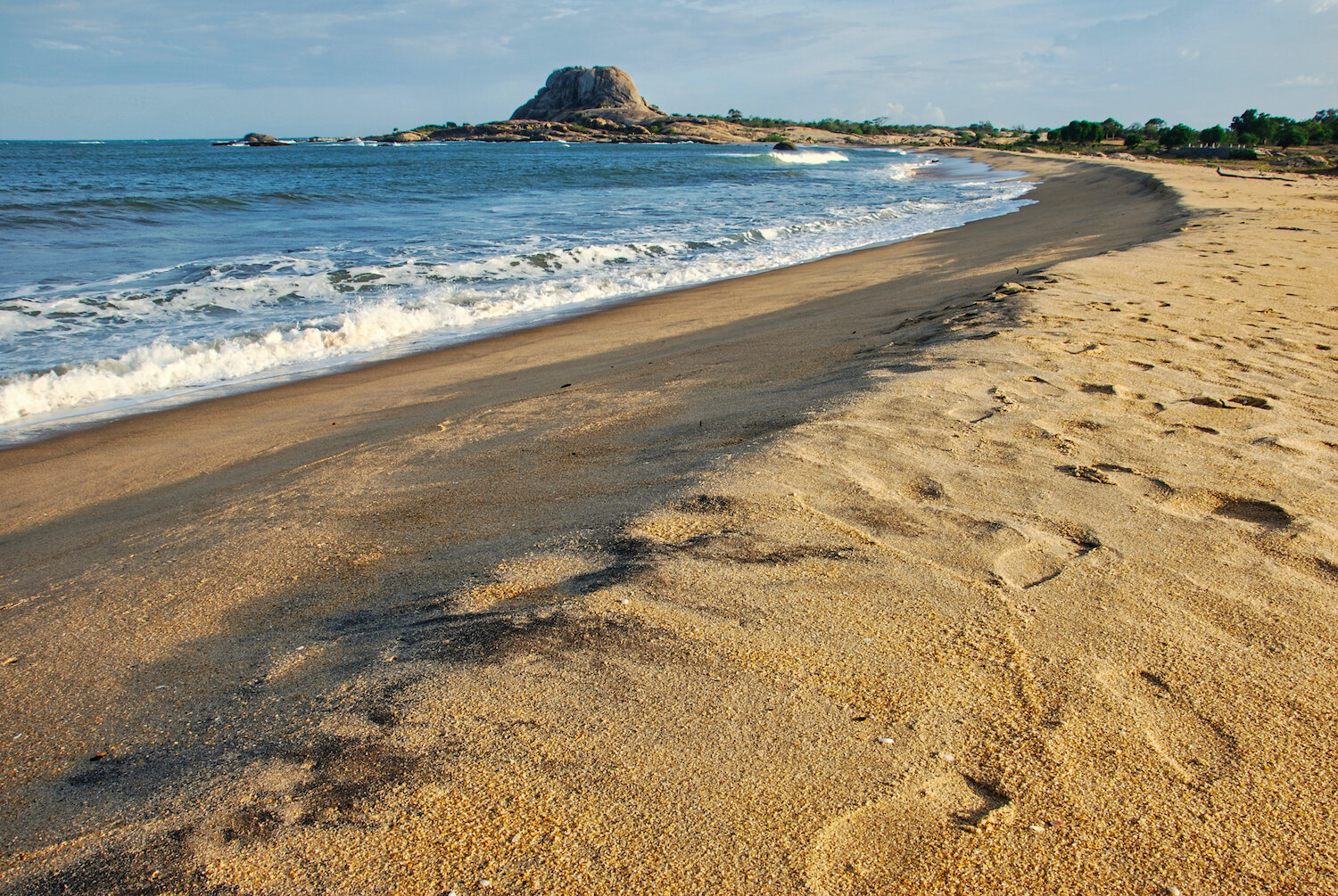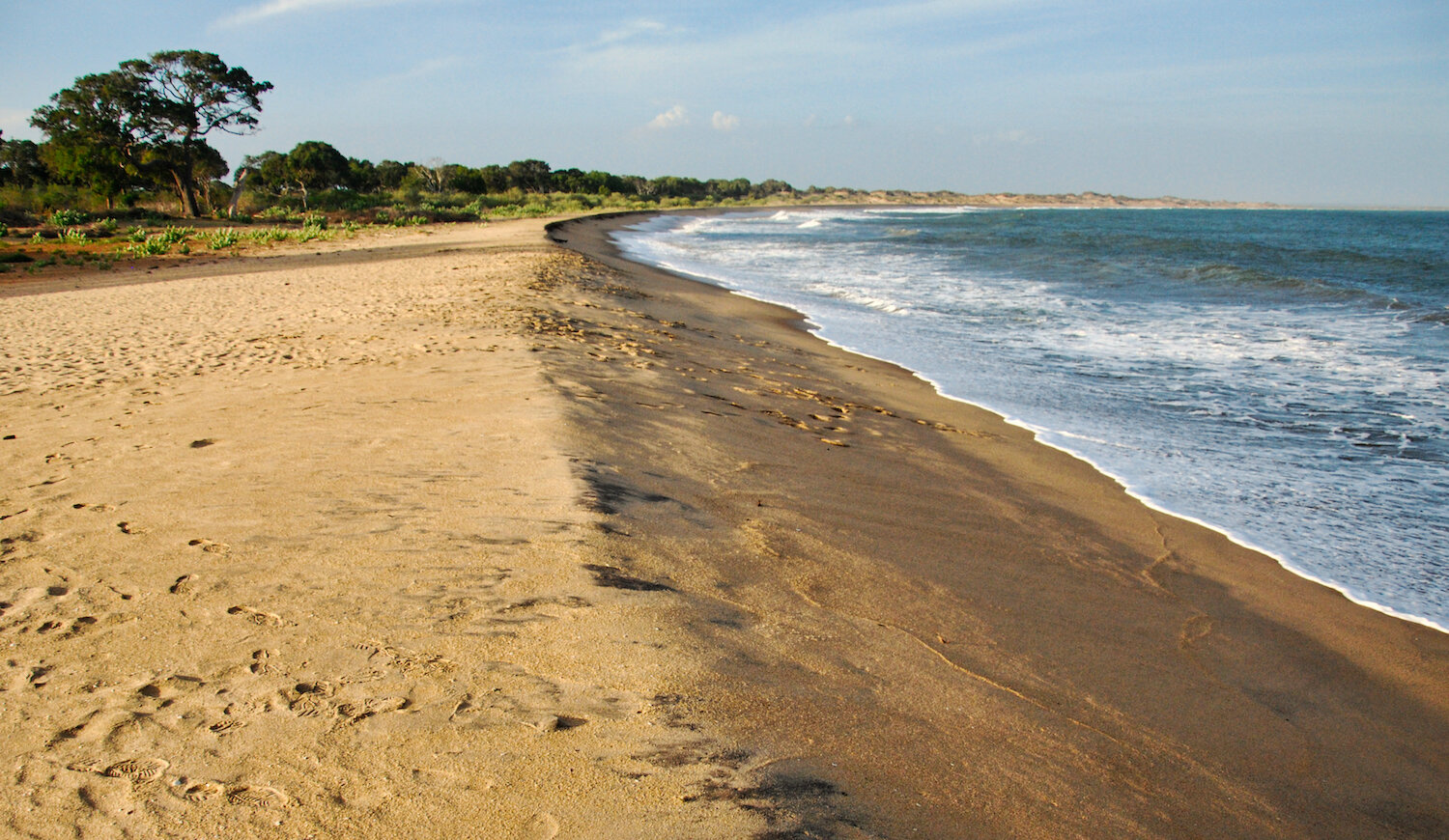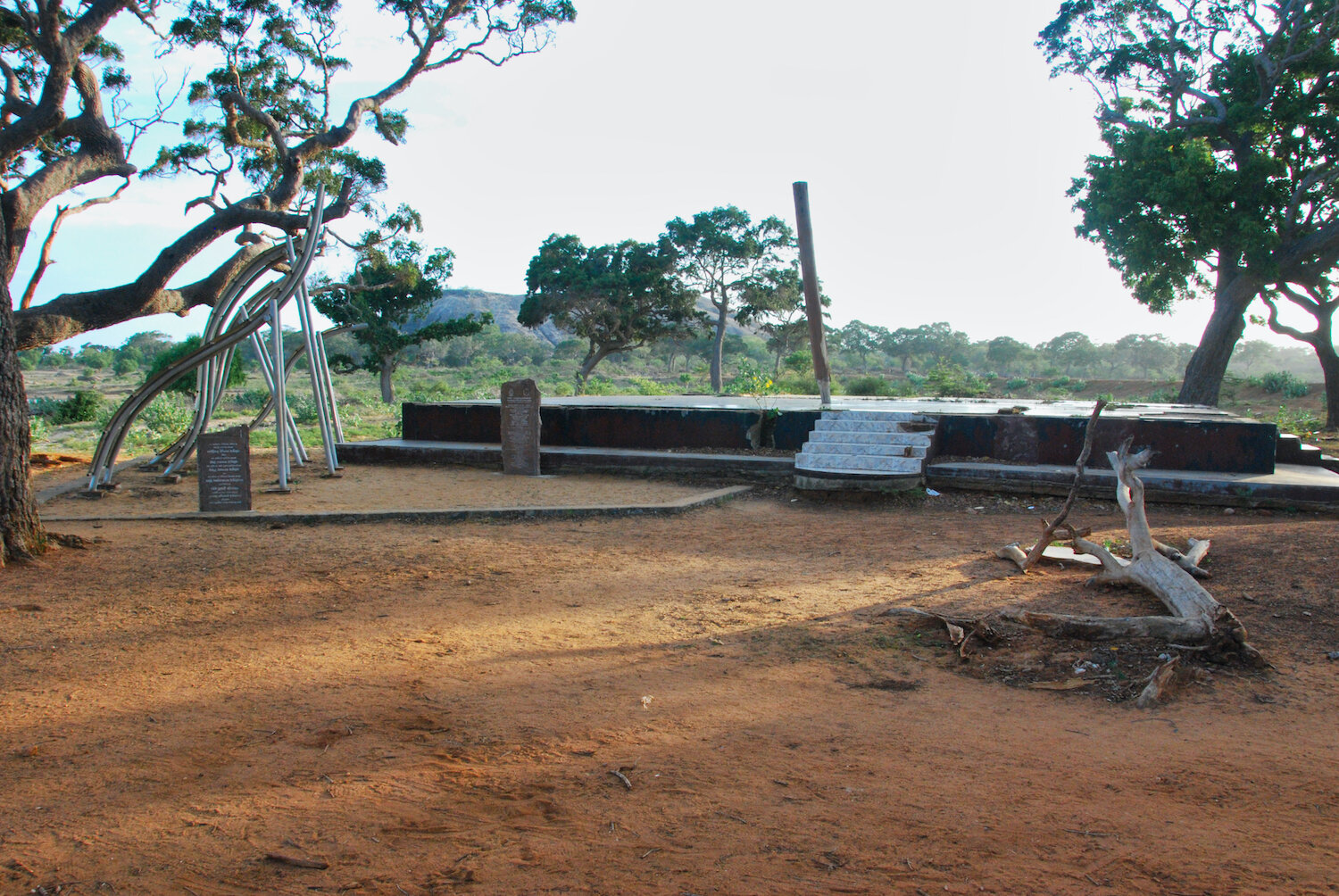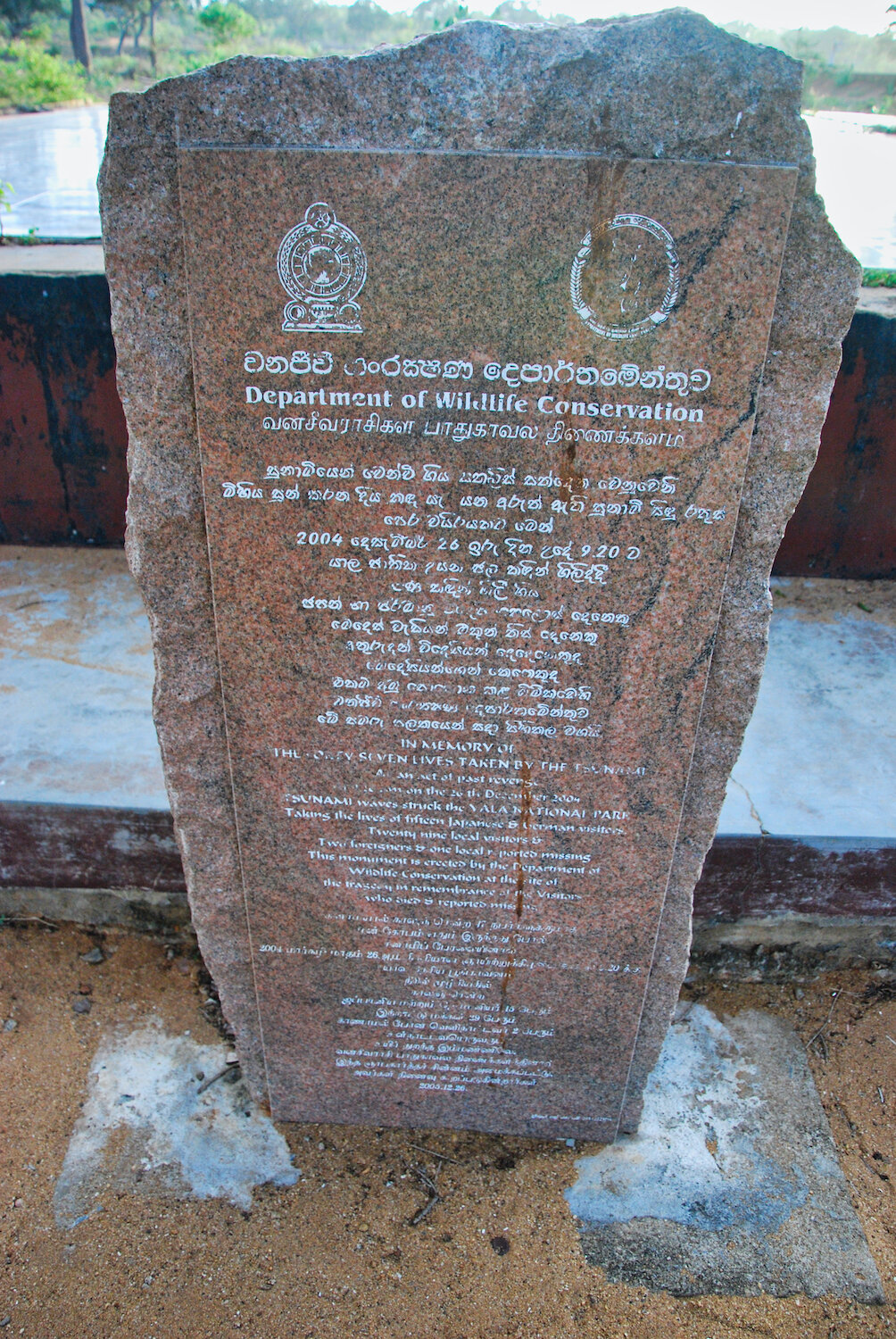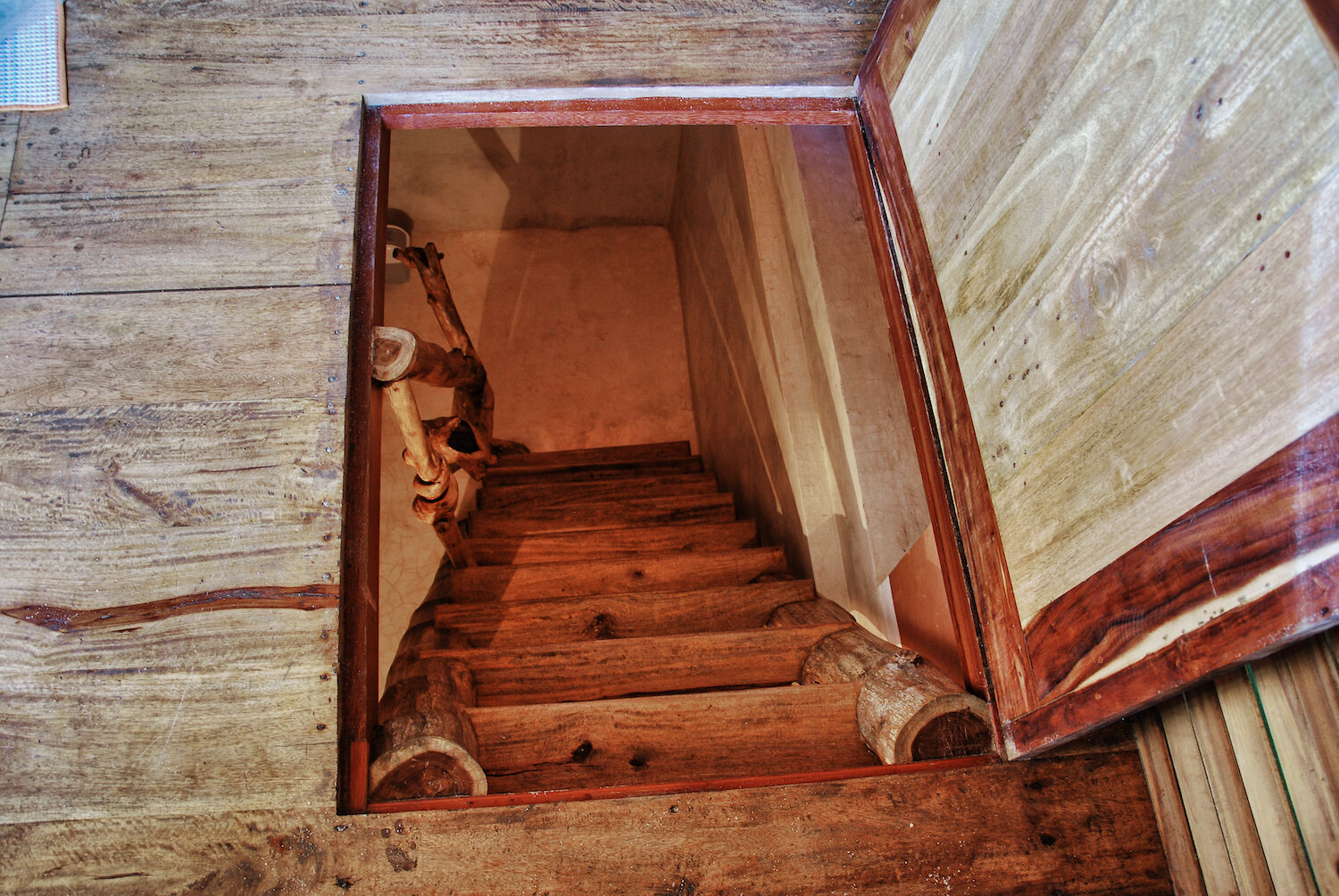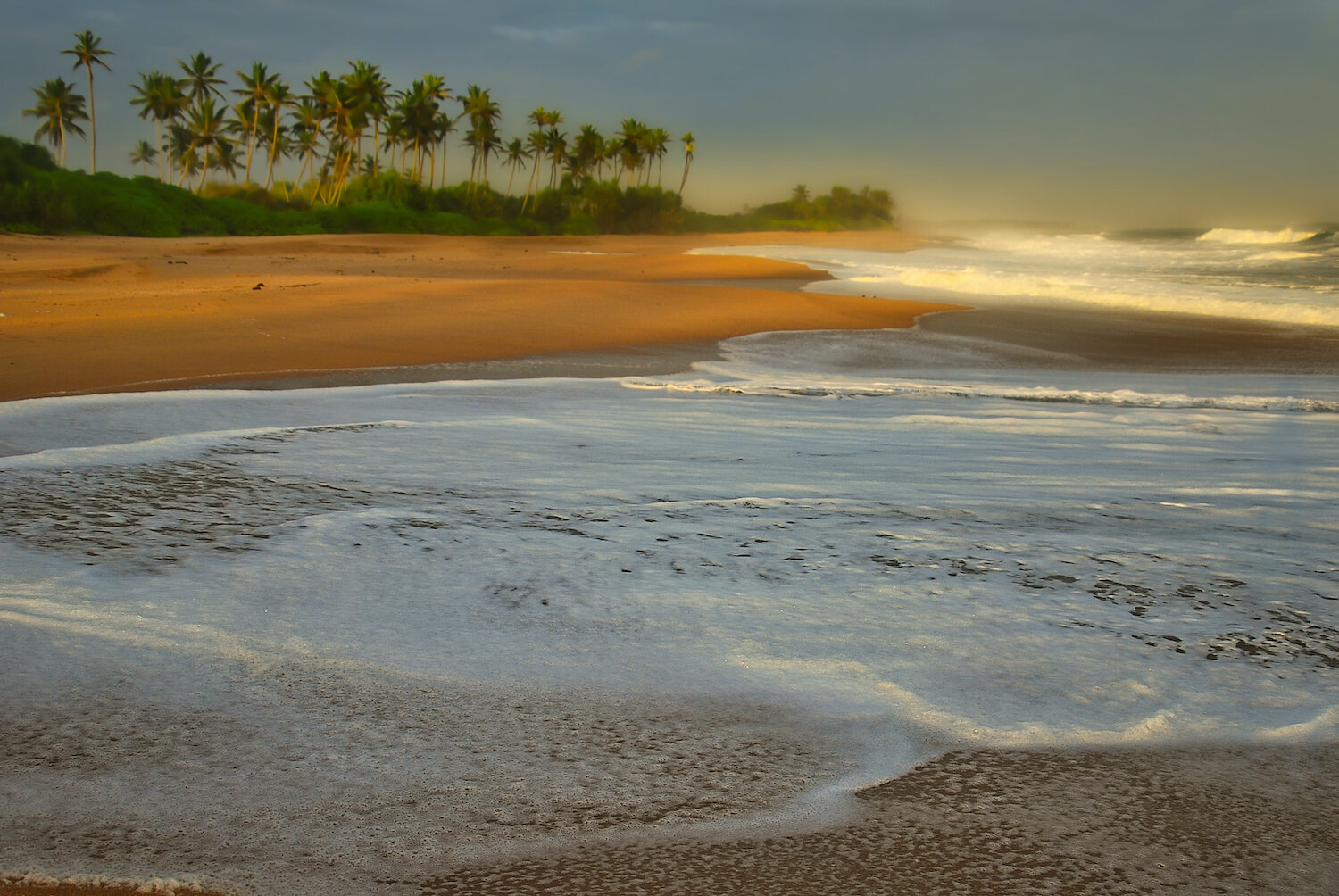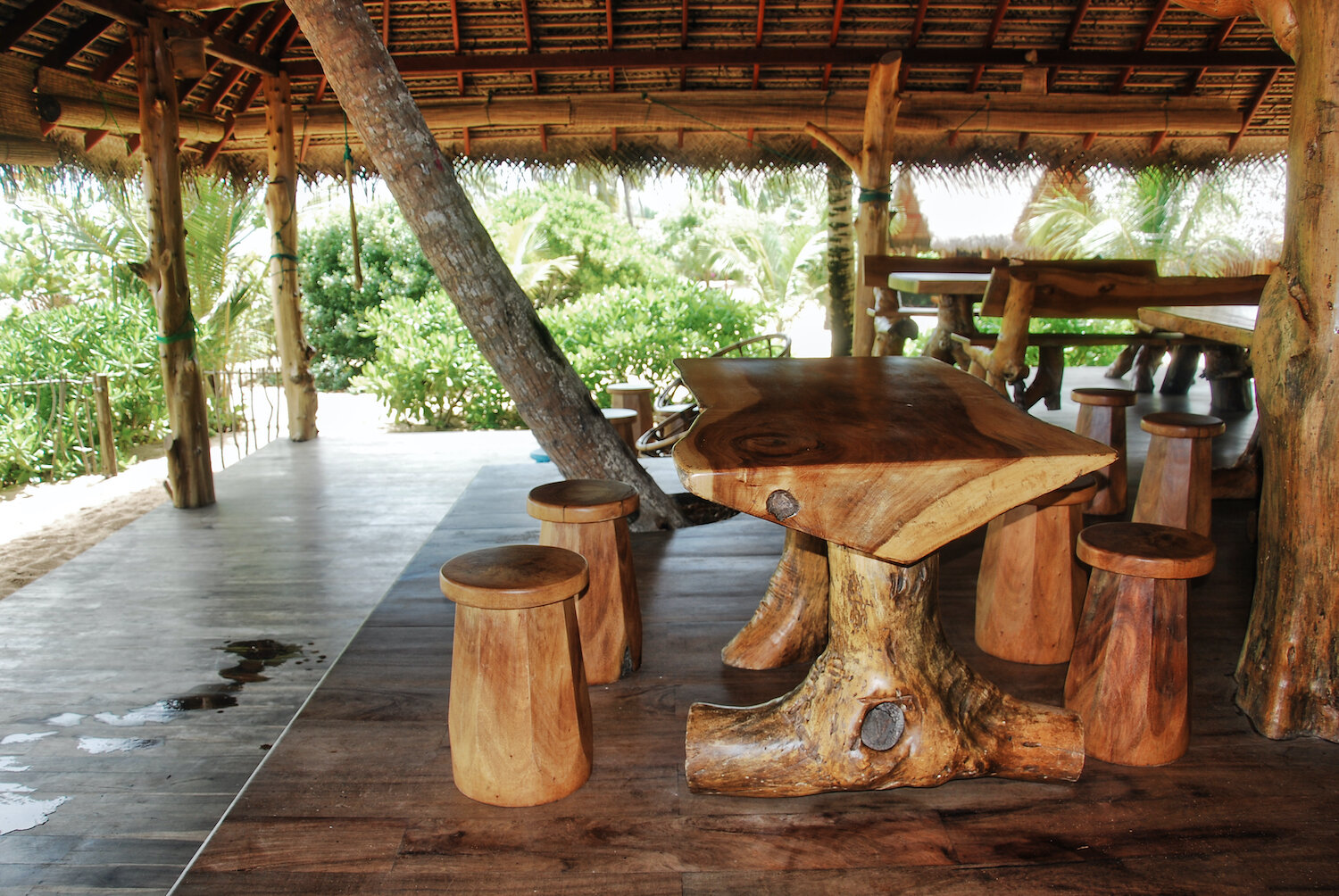77 -Yala to Marakolliya Beach (Southern Province, Sri Lanka)
“My days were a nebulous mix of nutrition injection and pointless activity, not the least of which was creating seashell mosaics in the sand. I’d sit and stare into the horizon for long stretches, breaking eye contact periodically to scan my east and west flanks. When sitting proved too much, I retreated to a hammock for rest and recovery. The exercise portions…”
by The Nostomaniac
BEACH TO BEACH WITH YALA IN BETWIXT. I drove east, then south to Tissamaharama. Pleasant skies, pleasant drive. The route from Buttala to Tissa had a sleepy, bucolic vibe, a vibe belied by a heavy military presence. Foxholes decorated the landscape at regular intervals. I took but one photo along the way for fear of attracting G.I. Sri Lanka’s ire. Filming military installations was a big no-no, and I wished to avoid the business end of an AK-47.
Why so serious? This route skirts Yala National Park, a past staging ground for the LTTE (Tamil Tigers). Tigers mined the hell out of the road during the conflict, and though the war was over, I felt like I was inspecting the front line. The army had cleared trees and brushes to improve visibility. Frequent checkpoints solidified the aurora of martial law.
Yala is nine hundred seventy-nine square kilometers of scrub, light forest, grassy plains, and brackish lagoons sprinkled with elephants, leopards, crocodiles, wild boars, honey bears, monkeys, mongoose, peacocks and a plethora of birdlife. It’s not the Serengeti, but well worth the effort… and expensive. No reason to revisit the financial frustration inherent in Sri Lankan NP tourism, so I’ll restrain myself.
In Tissa, I arranged a jeep with driver in the morning and was inside Yala by the afternoon. I’ve come to appreciate the wisdom of tampering expectations. Mine were low. Expect the worst, hope for the best and all that shit. No need in this case. The park is imbued with a quiet desolation and forlorn grandeur guaranteed to captivate. (Crowds would mitigate the effect, I’m sure.) The dusty conditions lent a desperation to the scene. Sri Lanka was recovering from war, Yala the dry season. Animals converged around surface water and were thus easier to spot. Elephants, crocodiles, mongooses, wild boar, peacocks, and deer all made cameos. It’s a shame I couldn’t include leopard on this list, and unlucky. Yala has the highest concentration in the world. Fooey.
The atmosphere was tense, as one might expect when prey and predator convene in close quarters. Two spotted deer edged their way closer and closer to a pond teeming with crocs. A few reptiles lounged nearby, thoroughly uninterested. I couldn’t say the same for one drifting toward shore submarine-style. Bambi and Rudolf took nervous sips from the water’s edge before moving on, forestalling doom.
Seaside Yala is equally compelling. A swift breeze conspired with a setting sun to solidify the park as one of my favorite places in the Sri. You could say the beach is haunting and haunted, poetic and tragic. On December 26, 2004, a tsunami killed forty-seven people (tourists and locals) at the site I visited. The first wave destroyed a bungalow mere yards from the ocean, likely surprising guests and staff amid breakfast. Some bodies were never recovered. Pathos, chaos, serenity, and beauty rolled together. Paradise to hell in an instant. Impossible to imagine.
I wanted to linger, but, alas, my time was short and with less than ten days left on my visa, I rambled on—Tissa to Marakolliya Beach. MB drew me in like quicksand, bogging me down for three nights. I’m not much of “spill and chill in the sand” sorta guy, but that place cast its spell. And by “place”, I mean Mangrove Garden and Cabanas, a superb hideaway owned and managed by a German woman (Miriam).
Life on the move is energy-intense—my batteries were drained, and I needed a recharge. Enter MB. I swore off shirts and shoes from the outset, never deigning to don either. The white noise effect of the incessant crashing waves lulled me to sleep each night. It wasn’t the common “ebb and flow, crash and thrush” most common to the genre but more of a constant crash akin to waterfalls. The one downside was its unsuitability for swimming. The violent intensity of the wash created dangerous undercurrents and bone-crunching force when climaxing on the sand. Going above the waist was risky at best.
This, for me, was a feature, not a bug and made for an exhilarating semi-aquatic diversion. The goal was to push far enough for a light thrashing but not so far as to damage the merchandise. I called my new game “Tsunami.” (Insensitive much?) Let a wave take you off your feet, then try to recover by jogging into the surf. This delighted me to no end. I was giddy as a schoolgirl, yipping with maniacal glee every time the ocean punished me for my insolence. Sand occupied my nooks and crannies, but it mattered not—a small price to pay for childhood simulation.
My days were a nebulous mix of nutrition injection and pointless activity, not the least of which was creating seashell mosaics in the sand. I’d sit and stare into the horizon for long stretches, breaking eye contact periodically to scan my east and west flanks. When sitting proved too much, I retreated to a hammock for rest and recovery. The exercise portions of my day included leisure strolls up and down the magnificent coastline or several blood-pumping rounds of Tsunami.
The bounty of the sea kept up my strength (in case I needed any). Prawns, calamari, butterfish, and other sea life I couldn’t be bothered to identify graced my plate and excited my palate. Not sure the staff ever saw someone eat like that (i.e. a first-world glutton). My recharge protocol included nutrient replenishment. I had yet to regain the lost pounds from my Indonesian fandango, so I had a go at MB. It wasn’t a cheap indulgence, but certainly a necessary one.
A two-hour coastal walk east led me past a neglected turtle sanctuary. Egg fragments littered the beach, and I caught a gargantuan lizard (at least four feet) raiding a hatching den. I’m guessing the outfit relied on volunteers, but there were none to be found. A regrettable state as I sense the turtles need all the help they can get. As it stood, the operation was more of an open buffet for resident predators.
There were things to do, sites to see. Rock temples, mangrove lagoons, a blowhole or two. I just couldn’t pull myself away, afraid to break the spell. Stepping outside was enough. Instead of fighting windmills, I admired rainbows. When ravens filled the sky, I channeled the ghost of Edgar Allen Poe. Their manic garble was a refreshing change from the relentless “cock-a-doodle-doo” of their fowl brethren. When an attractive German tourist refused to acknowledge my existence, I cherished from afar, too tranquilized to engage. How could I leave all that?
MB nights were superb. A waxing moon obscured the seashore beneath a silvery sheen—a chimerical realm torn from the pages of fantasy fiction. I understood why turtles came there to lay their eggs, that’s where I’d lay mine. I conducted reconnaissance but failed to catch any in the act. Didn’t matter, set and setting were reward enough. The thunder rolled (i.e. waves crashed), I haunted the coastline until my comfy cabana summoned me to bed.
One snag—sand fleas. Their size (equivalent to a grain of pepper) betrayed their dermatological impact. Those little bastards tormented my dreams no matter how meticulous my pre-bed shower routine. The nocturnal itchfest disrupted my slumbers, but this wasn’t a fatal blow to sleep quality. Somehow I endured. That’s what troopers do.
The elegant and capacious underground cabana bathrooms deserve special note. Their trap-door entrance design is an ingenious space-saving touch of convenience. Need to drop a bomb in the bomb shelter? Raise the roof (of the bathroom) and descend. Feel free to yell, “DEF CON 1” as you do so. I did. I wouldn’t recommend leaving the door ajar at night. The stairway is steep and caution be thy guide even under optimal lighting conditions. A tumble could be disastrous. Still, I like the idea of having to earn my bowel movements.
Mangrove Gardens and Cabanas wasn’t Miriam’s first hospitality rodeo. The 2004 Tsunami demolished her guesthouse… with her in it. One minute she was eating breakfast, the next she was submerged under a few meters of ocean. She spoke of the disorientation, the difficulty of swimming with no concept of up or down. Seconds of terror felt like an eternity, seconds that could’ve been her last. After coming to rest on solid ground, she had the wherewithal to climb a nearby tree.
The next hour brought an uneasy truce between relief and horror. Was it over? She watched two lesser aftershock waves flood the site before concluding it was safe to climb down. Watched? More like listened. Without her glasses, Miriam was nearly blind—blind and almost naked with a puncture wound on her leg requiring attention. An employee in an adjacent tree came to her aid, he and a friend helped her to the main road, placed her on a motorcycle, and shuttled her to a medical station… where she was told they could do nothing for her.
Quasi-medical clinics abound in Sri Lanka. Got a fever? Small boo-boo? They can help. Got flattened by a tsunami? Open flesh wound? Big boo-boo? Sorry. So, authorities called an ambulance which carried her farther west to a small hospital. No antibiotics. No painkillers. No anesthesia for minor surgery. Miriam wasn’t classified as critical (rightly so, she admitted), so she would have to sit on the back burner. But her situation deteriorated and, between bouts of agony, she pleaded for transport to a proper hospital in Columbo. Her trip was short—no fuel. Saltwater contamination fouled fuel tanks on the coast. She was forced to return. Volunteers located a second truck with a full tank and sped toward the capital. It took all day, but she made it.
Miriam’s close friend (one who’d assisted her Columbo plight) saw the tidal wave moving in and climbed a coconut palm in anticipation. After descending, he began a frantic search for her. With the area flooded, he thought a boat might aid rescue. He ran along the coastline a considerable distance to a naval station, but all boats were damaged or aloft in trees. He ran back to continue the effort.
Upon return, a friend told him she hadn’t survived. He was devastated, but it didn’t take as he soon learned it was a case of mistaken identity. Though overcome with joy, he was less than amused when he discovered the dead woman looked nothing like Miriam. (All white women look alike, eh?) Finally, he found her and helped her to safety, so all’s well that ends well. (At least for her—tens of thousands weren’t so lucky.)
Miriam’s sister flew out that morning after an extended visit. Upon hearing of the tragedy, she tried to return, the but international airport was closed, all flights canceled. More than a day passed before she received word. Miriam wanted to call but no hospital phones could make IDD (International Direct Dialing) calls. Pain and medication blunted her cognition, borrowing a cell phone hadn’t occurred to her. When the pain subsided, she implored the doctor to text her sister in Germany.
(How’s that for a tale? Kudos to Miriam for sharing her story, another reminder why I saddled up and hit the road.)
Can’t keep a good woman down. Miriam purchased beachfront property for the bargain-basement price of 60,000 euros (~$85,000). A few years later, a hotel conglomerate offered her a million dollars to build a five-star hotel on the chalet site. She said no. Why should people pay $500 a night to enjoy that beach? A posh hotel didn’t belong. I agreed. Go Miriam.
She had five ferocious guard dogs patrolling her property after-hours. If you’re a tourist or an employee, you had nothing to fear. Everyone else? Be afraid. Be very afraid. I crossed one area and received an intimidating (and I do mean intimidating) rush and howl. Miriam informed me they were all bark and no bite… unless your skin is dark. There were testimonials. A man selling postcards on the beach confirmed this: intruders should stay away or risk severe bodily injury. That’s not to say if I’d tried to sneak on the grounds I would’ve been safe. At that point, all bets were off. In certain contexts, Team Cujo was color blind. Stray dogs had it worse. A misstep could be fatal. No mercy to man or fellow canines.


